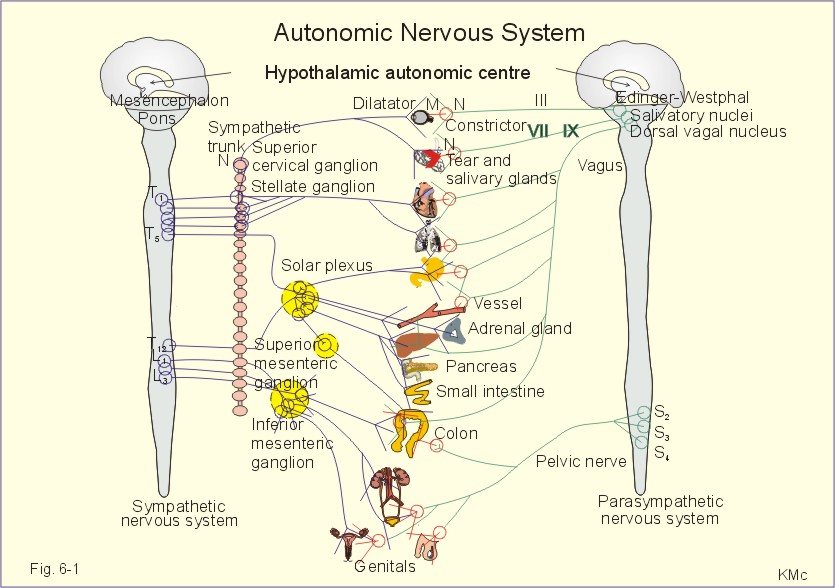|
|
|
Anesthesia Pharmacology Chapter 4: Autonomic (ANS) Pharmacology: Introduction
|
|
|
|
|
 |
|
Figure by Poul-Erik Paulev, M.D., D.Sci, used with permission |
|
|
|
|
|
|
Autonomic and Somatic Innervation
Skeletal muscle is innervated by somatic nerves, controlling voluntary actions
All other innervated structures are supplied by the autonomic or involuntary system.
Somatic system: No ganglia present
Autonomic nervous system (ANS) has ganglia.
these ganglia are sites at which preganglionic fibers form synaptic connections with postganglionic neurons
these ganglia are located outside the cerebrospinal axis
Other differences between Somatic and Autonomic Innervation
Motor nerves to skeletal muscle: myelinated
Postganglionic autonomic nerves are nonmyelinated
Denervation of skeletal muscle results in paralysis and atrophy
Denervated smooth muscle or glands retain some activity
First link: Visceral autonomic afferents to the CNS
Non-myelinated, carried to the cerebrospinal axis by autonomic nerves (e.g.vagus and splanchnic)
Some autonomic afferents from skeletal muscle blood vessels and integumental structures may be carried in somatic nerves
Cell bodies of visceral afferents: (a) spinal nerves--in dorsal root ganglia; (b) cranial nerves-- in sensory ganglia
What information gets transmitted?
Mediated Information:
Visceral sensation (pain; referred pain)
Vasomotor reflexes
Respiratory reflexes
Viscerosomatic reflexes: Definition: Viscerosomatic: Pertaining to the viscera and body
|
Figure by Poul-Erik Paulev, M.D., D.Sci, used with permission |
|
|
|
Substance P is an important sensory neurotransmitter, probably especially important in nociception, and is found in:
Sensory afferent fibers
Dorsal root ganglia
Dorsal spinal cord horn
Other agents found in sensory neurons
Somatostatin
Vasoactive intestinal peptide (VIP)
Cholecystokinin (CCK)
Calcitonin gene-related peptide (CGRP) (found with Substance P in cardiovascular sensory nerve fibers)
Dorsal Spinal Cord (substantia gelatinosa) Interneurons
Enkephalins: Antinociceptive due to inhibition of substance P release and reduced transmission to higher centers
CNS and the Autonomic Nervous System
Sweating
Blood pressure changes
Temperature-induced changes in vasomotor tone
Emptying of the bowels, bladder, seminal vesicles
Hypothalamic and Nucleus tractus solitarii
Integration of ANS Functions
Body temperature regulation
Emotions
Water balance
Sexual response
Fat/carbohydrate metabolism
Sleep
Blood pressure
Respiration
Posterior and Lateral Hypothalamic Nuclei are associated with integration of autonomic sympathetic input
Midline nuclei in the region of the Tuber cinereum and anterior nuclei Nuclei are associated with integration of autonomic parasympathetic input
Sympathetic: (Thoracolumbar outflow)
Parasympathetic; (Craniosacral Outflow)
![]() Autonomic Nervous System Neurotransmitters: Summary
Autonomic Nervous System Neurotransmitters: Summary
Neurotransmitter: Acetylcholine
All preganglionic autonomic fibers
Parasympatheticfibers
A few post-ganglionic sympathetic fibers
Neurotransmitter: Norepinephrine
Postganglionic Sympathetic Fibers
Neurotransmitter: Primary Afferents: Substance P and/or glutamate
Lefkowitz, R.J, Hoffman, B.B and Taylor, P. Neurotrasmission: The Autonomic and Somatic Motor Nervous Systems, In, Goodman and Gillman's The Pharmacologial Basis of Therapeutics, (Hardman, J.G, Limbird, L.E, Molinoff, P.B., Ruddon, R.W, and Gilman, A.G.,eds) TheMcGraw-Hill Companies, Inc.,1996, pp.105-107.